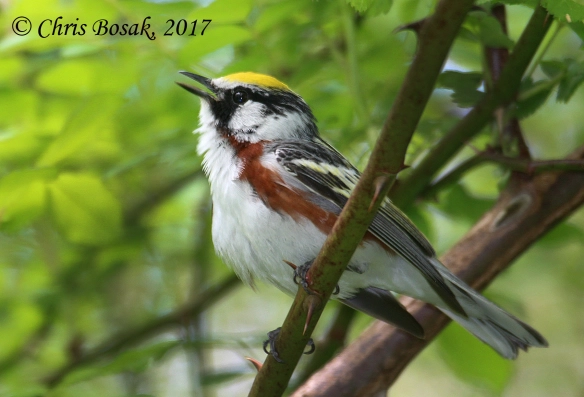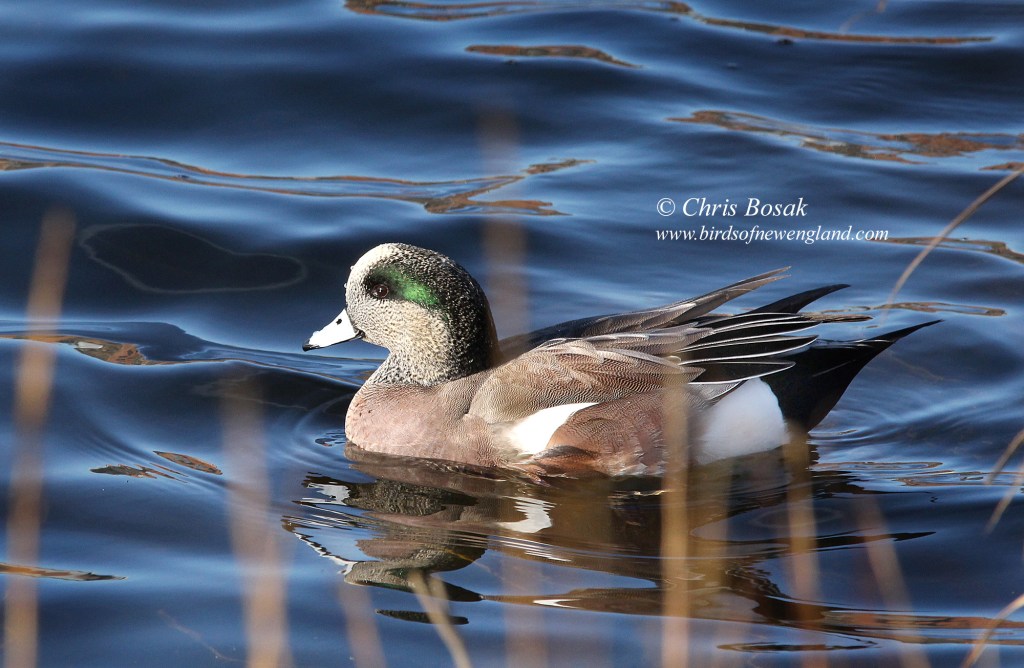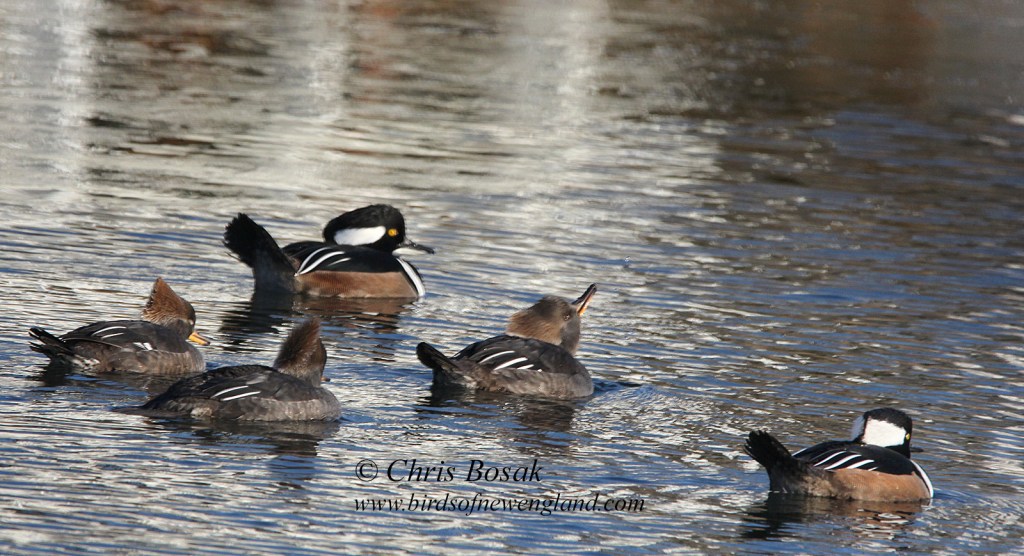
Here’s a magnolia warbler I encountered during a recent gray morning.


Here are a few more shots of the Louisiana waterthrush I saw the other day. Waterthrushes look like thrushes and even have thrush in their name, but they are actually warblers.




I saw a yellow-rumped warbler, a few pine warblers and several palm warblers on my last bird walk. That can only mean one thing: time for my annual spring warbler column.
The aforementioned warblers are the earliest to arrive in New England in the spring. The rest will follow shortly.
But first, what is a warbler? A warbler is a small Neotropical songbird. Many are colorful but not all of them. Yellow is a common color among warblers, but white, black, orange, brown and tan are also found frequently on warblers. While some spend their winters in the southern part of the U.S., most migrate farther to Central or South America, or the islands south of the U.S. A few stragglers may be spotted in New England during the winter, but it’s not common.
Warblers breed throughout the U.S., mostly in the northern states and into Canada. By late September and into October, warblers do their southward migration. In April and May, they pass through the area again — this time in their fresh spring plumage.
Many warblers will remain in New England to raise families, and others will head farther north. Yellow warblers and common yellowthroats, for me anyway, are the species most commonly seen during the summer raising their families. I’ve also found the breeding spots of American redstart, ovenbird, pine warbler and a few other species.
Warblers are best known in New England for their spring migration. In their best breeding plumage, dozens of species of warblers pass through New England in April and May with the peak being the first two weeks in May. This also coincides with the return of other colorful songbirds such as rose-breasted grosbeak, scarlet tanager, indigo bunting and Baltimore oriole.
Watching warblers can be incredibly rewarding and frustrating at the same time. With a few exceptions, warblers do not visit birdfeeders, meaning they must be found “in the wild.” Sometimes they are easy to find, but usually they are flitting among the leaves and hard to pinpoint. The typical size of a warbler is about five inches, so it’s not like trying to find a blue jay or robin.
Their songs are usually sung softly, so it takes a good ear to find them that way too. Also, there are dozens of warbler species and learning their songs, while infinitely valuable when in the field, is not the easiest task. Try the Merlin app to help identify warblers by song. Remember, though, while the app is extremely helpful and accurate, it is not 100 percent accurate. It’s best to “get eyes” on the birds in addition to having Merlin ID it by sound.
Some of the most common species to look for include the yellow warbler, yellow-rumped warbler, American redstart, common yellowthroat, northern parula, chestnut-sided warbler, blue-winged warbler, black-and-white warbler, black-throated green warbler, black-throated blue warbler and magnolia warbler. Ovenbirds, whose loud “teacher, teacher, teacher” song if often heard in the New England woods in the spring, are also warblers.
As I mentioned, there are dozens of other warbler species that pass through or breed in New England. A good field guide, whether an app on a smartphone or an old-fashioned paper book, is a must for identifying warblers. I wish I could describe each warbler in detail here, but obviously, that’s not feasible.
The spring warbler migration is a highlight of the year for many birdwatchers, myself included. There will be a dizzying assortment of birds to find in the coming weeks. Let me know your highlights.

Another warbler season is in the books.
Sure, there are still the late-migrant stragglers that will be seen into mid-June and, of course, the ones that will nest and stay with us all summer, but the peak of the warbler season has, sadly, passed.
For me personally, I did not see a huge variety of warblers, but I did see plenty of the more common warbler species over the last few weeks.
The warbler sightings, for me, started in late April with a walk that yielded dozens of yellow-rumped warblers. Over the last few weeks, it has been largely blue-winged warblers, common yellowthroats and American redstarts. In the last week or so, yellow warblers have been showing up more and more on my walks and are becoming the dominant warbler species.
Those are also the main warblers that will nest in my area of New England. Each part of New England has its common nesting warblers and, thankfully, we will get to see them throughout the summer. If we are lucky, we’ll see their youngsters too.
It has been fun over the last couple of years getting to know the American redstart and blue-winged warbler better. I found a few places where redstarts nest, and I visit there frequently in late spring into early summer. Redstarts are, in my opinion anyway, one of the more interesting-looking birds and remind me of Halloween every time I see one. The black and orange coloring is unique in the warbler world. At least among the ones we see in New England.
Blue-winged warblers are largely yellow, like many warblers that nest or pass through New England, but their unique, black eye straight gives them a different type of look – almost like a little bandit. Blue-winged warblers are also unique and fairly easy to find from their insect-like call. It appears to be a rather subtle call, but it can be heard from far away, especially during an early morning walk when the world is still quiet and calm.
Yellow warblers and common yellowthroats will nest throughout New England. In both cases, the birds are usually heard before they are seen. That is if they are seen at all, as they like to hang out in brushy areas and remain hidden if possible. Yellowthroats often like to stay low to the ground in their skulking.
I’ve focused on warblers in this column, but I also had some good luck finding other colorful songbirds such as rose-breasted grosbeak, indigo bunting and scarlet tanager. I watched a female rose-breasted grosbeak collect nesting material a few weeks ago. It’s good to know they will be sticking around and raising young here.
With spring migration mostly behind us, what’s next for birders? Birds won’t be as noisy or active as they have been over the last several weeks, and the variety won’t be as great, but watching them raise young is always a highlight of late spring and early summer. Of course, many birds have had their first broods already, but the nesting and rearing will last for the next few months.
Every season has something to offer birdwatchers. There’s always something interesting to observe so be sure to get out there as much as possible.

Sometimes you just have to be patient. I tell myself that every year but rarely, if ever, do I heed my own advice.
I am so eager for the spring migration to hit full swing that I start tromping through the woods starting in mid-April expecting to see all the explosive colors of the northward songbird migration through New England.
Walk after walk in late April and early May yields some great birds but not the full-on spring spectacle. Finally, one day in mid-May, I get that walk I have been waiting for with colorful birds all around. Patience is key, sure, but that’s easier said than done.
That walk happened for me the other day when I got up early and hit the nearest park. The action started right away with an eastern towhee. It was one of the few towhees I saw on the walk compared to the dozens of towhees I had seen during my late April walks. Most of the towhees have either moved north or settled into their nesting season and are remaining quiet and out of sight.
Then I heard a familiar song from the tree above me. The distinctive “chick-bree” call could only be a scarlet tanager. Despite their awesome coloration, male scarlet tanagers can still be difficult to find among the leafed-out canopy. I had little trouble finding this guy, however, as he flew from one tree to the next revealing its impossibly red plumage in the golden morning light of the rising sun.
As I continued down the trail, the colors continued: the beautiful red upside-down triangle of the rose-breasted grosbeak, the electric orange of the Baltimore oriole, the dazzling blue of the indigo bunting, the bright yellow of the blue-winged warbler and the slightly darker yellow of the yellow warbler. Bobolinks and red-winged blackbirds brought life to the meadow.
The great sightings didn’t stop with the colorful birds as there were plenty of “dull” birds to see as well. Among the highlights were yellow-billed cuckoo, field sparrow and ovenbird. And lots of catbirds. Lots and lots of catbirds.
The sounds of the birds add to the magic. The insect-like buzzy song of the blue-winged warbler and tropical-like odd song of the cuckoo stood out among the rest.
It was the walk I had been anticipating for nearly a year. I enjoy New England year-round and each month has its special gifts for birdwatchers, but that mid-May walk when everything comes together never gets old.
If only the magic lasted longer. It’s called the peak of migration for a reason. Just as it has to build to its high point, so too will it now taper off as birds continue to push north or settle into nesting and go quiet.
Enjoy these days while they last. The color and variety are spectacular and unmatched by any other time of year.

It was an abbreviated Christmas Bird Count for me this year due to nagging foot problems and family obligations. I’ll take it, though, as I missed last year completely due to the foot problems. Progress is good.
Frank, Tom and I packed a lot into the time we did have together. Tom and I ducked out early, and Frank birded until dark. I was there for a good cross-section of water and land hot spots. Some highlights included 3 warbler species (pine, yellow-rumped and Nashville), red-breasted nuthatch, American wigeon (close views), common goldeneye, common and red-throated loon, and American pipit.
Click here for more information about the Christmas Bird Count, one of the longest-running wildlife censuses in the world.
Here are a few more photos from the day. It was good to be back out there. Hopefully next year I’ll be back at full strength.




People love fall for a variety of reasons.
Cooler temperatures, Halloween decorations, fall foliage, football, and, of course, pumpkin spice. Everybody claims to hate pumpkin spice, but they wouldn’t make it if people weren’t buying it.
For me, I love fall for the bird migration – obviously. I particularly like finding fall warblers. It is especially rewarding when I stumble across a small flock of fall warblers.
Palm warblers and yellow-rumped warblers are the prime candidates to find in small flocks. Such was the case the other day when I found a group of about a dozen palm warblers eating seeds from the dying weeds and flowers in a meadow.
Large flocks of yellow-rumped warblers are fairly common to come across as well. Just be on the lookout as you never played know where you will find them. I have usually found them eating small berries of some sort.
Continue reading
It is hit or miss when it comes to photographing birds. It is mostly miss, but that just makes the hits even more rewarding.
Once in a great while, I have come across very cooperative birds. One of the more memorable times took place on a small lake in New Hampshire where a great blue heron stalked its prey on the shoreline as I silently approached in my canoe. The bird never broke its glance on its prey as my canoe drifted into range.
There have been a few times when a loon, or a loon family, has approached me in my canoe. Talk about a wonderful experience, especially when they sing or call from close range. There is no better wilderness experience than that.
Feeder birds can often make for a similar experience, but there is nothing like finding a cooperative bird in the wild. This particularly goes for birds that you otherwise wouldn’t see in your backyard. These moments come along often when I visit family in Florida, but New England birds are much more challenging.
Continue reading
Here’s a shot of a male common yellowthroat. They are a common warbler that nests throughout most of the U.S. and into Canada. They migrate south in the fall, but in my observations, stick with us a little longer than many of the warblers.